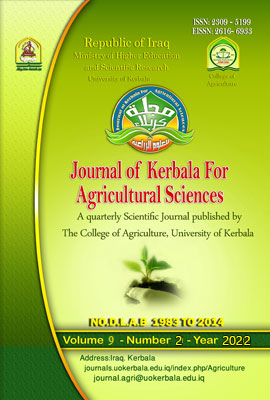Effect of Nano and Organic fertilizers on some vegetative growth characteristics of Phoenix dactylifera C.V Khastawi
DOI:
https://doi.org/10.59658/jkas.v9i2.957Keywords:
Chlorophyll, dry weight, leaf length and wet weightAbstract
The experiment was conducted in Al-Hussainiya palm plant / Holy Karbala governorate affiliated to the Ministry of Agriculture /Horticulture Department during the growing season of 2021 AD, with the aim of knowing the effect of nano-fertilizers and marine extracts on some vegetative growth characteristics of the date palm variety Al-Khastawi .A two-factor experiment was carried out according to a randomized complete block design (RCBD) with three replications, first factor was the addition of nano-fertilizer to the soil at four concentrations (0, 0.5,1 ,1.5 ml . liter-1. palm-1) while the second factor included spraying with algal extracts fertilizer at four concentrations (0, 1.5, 2.0 ,2.5 ml. liter-1. palm-1) where the nano-fertilizer was added to the soil by three additions and at the rate of one addition per month, while the spray treatment with algae fertilizer was six sprays between each spray and two weeks, and it was the first addition of nano-fertilizer to trees. The date palm was dated 1/3/2021, while the first application of algal fertilizer was on 3/3/2021. The results showed that the treatment with nano-fertilizer at a concentration of 1.5 ml. liter-1. palm-1 was significantly superior in most of the studied traits (leaf length 3.38 cm, wet weight 41.19 gm). Furthermore, the treatment of spraying with algal manure extract at a concentration of 2.5 ml. liter-1. palm-1 was significantly superior in most of the studied traits (leaf length 51.83 cm, dry weight 56.96%, chlorophyll 12.56 mg g-1). Additionally, the interaction between the two fertilizers, nano-fertilizer and marine algae extracts, showed significant superiority in all studied traits.
Downloads
Published
How to Cite
Issue
Section
License
Copyright (c) 2022 Copyright (c) 2024 is the Author's article. Published by the Journal of Kerbala for Agricultural Sciences under a CC BY 4.0 license

This work is licensed under a Creative Commons Attribution 4.0 International License.
Licensing Terms
All articles are published under a Creative Commons License and will be directed to the Creative Commons Attribution 4.0 International License (CC BY 4.0) That permits use, distribution, and reproduction in any medium, provided the original work is properly cited. This license also allows the work to be used for commercial purposes.
Use by both non-commercial and commercial users
This content is licensed under a Creative Commons Attribution 4.0 International (CC BY 4.0) license, permitting use by both non-commercial and commercial users. Individual users may access, download, copy, display, and redistribute the articles to colleagues, as well as adapt, translate, and text- and data-mine the content, subject to the following conditions:
- The author's moral rights, including the right of attribution and the right to protect their work from derogatory treatment, are respected.
- Where content in the article is identified as belonging to a third party, users must ensure that any reuse complies with the copyright policies of the owner of that content.
- If the article content is reused for research or educational purposes, users should maintain a link to the appropriate bibliographic citation, including the DOI and a link to the published version on the journal's website.

